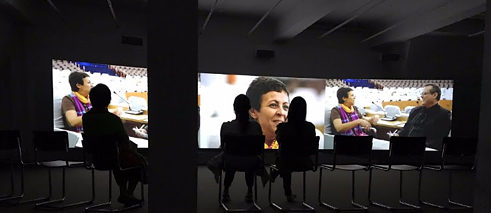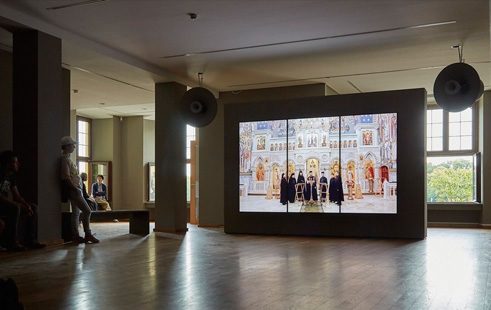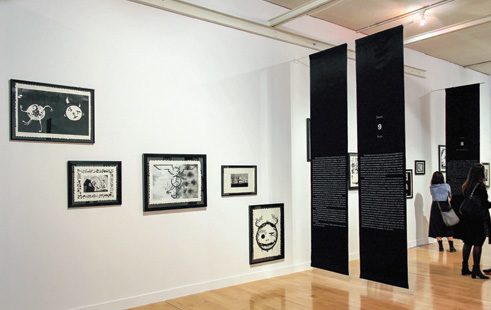Knowing the World Through Art:
Thoughts about some of the artworks at documenta 14

The practical view that going to Anglo-Saxon countries goes hand in hand with for a better education or a more advanced life infrastructure has already begun to collapse. What are people searching for now? A myriad of possibilities to move ideas from certain directions and activate them in their own respective living space
When Pius Sigit Kuncoro, the selected curator for the Biennale Jogja 2017, visited Brazil, the Goethe-Institut organized an event that brought him together with Jochen Volz (curator of the 32nd Sao Paulo Biennial) and Monika Szewczyk (one of the curators of documenta 14). The common threads behind the different events that brought them together were “Living Uncertainty”[i], “South as state of mind”[ii], dan “Khatulistiwa”[iii]
Simply put, these three themes convey that post-colonialism is not a relevant framework for critical thinking today. The practical view that going to Anglo-Saxon countries goes hand in hand with for a better education or a more advanced life infrastructure has already begun to collapse. What are people searching for now? A myriad of possibilities to move ideas from certain directions and activate them in their own respective living space.
 Romuald Karmakar, BYZANTION (2017). Installation view at documenta 14, Kassel, 2017
| Photo by Benjamin Westoby for Artsy
Goethe-Institut Indonesien facilitated my trip with a few other colleagues from the art scene to Athens and Kassel to visit the documenta 14. Moe Satt (one of the artists in our group) inquired about a label of an artwork in Athens that did not include the year of birth of the artist, whereas in Kassel, this very information was provided. Hendrik Folkerts, one of the curators of documenta 14, explained that this distinction was owed to the decision of the design team, not that of the curators.
Romuald Karmakar, BYZANTION (2017). Installation view at documenta 14, Kassel, 2017
| Photo by Benjamin Westoby for Artsy
Goethe-Institut Indonesien facilitated my trip with a few other colleagues from the art scene to Athens and Kassel to visit the documenta 14. Moe Satt (one of the artists in our group) inquired about a label of an artwork in Athens that did not include the year of birth of the artist, whereas in Kassel, this very information was provided. Hendrik Folkerts, one of the curators of documenta 14, explained that this distinction was owed to the decision of the design team, not that of the curators.
For me, the curatorial decision to mention the birthplace of the artist, but not the home country, was quite an interesting choice. This simple decision, not to mention the country, is actually very political as well as strategic because it presents the smallest living space in which the work and the performance of the artists can be seen in an appropriate framework and context – of course, only when they allow it.
the Hessisches Landesmuseum
I even followed the sound of a voice, assuming that the video it came from wasn’t part of the museum’s collection. When I walked in, the video narrator was explaining that the location of the ongoing conversation on three screens was in fact the room where the first meeting of the Non-Aligned Movement took place in 1973. Automatically, I walked out to take a look at the exhibition label to see how long the duration of the video was, and went back inside.I often wondered, how many people have watched this video from beginning to end? How many visitors (who are not particularly interested in the topic, the artist or video as an art form) have really sat down and watched until it was over? And does this matter to the artist? I don’t know... What I know for sure is that the 85 minutes I have spent in the presence of Naeem Mohaiemen’s artwork have made me more aware of Bangladesh’s post-independence position and made me think about what it means to be connected to non- G20 countries nowadays. How can we connect? Why are we still connected? Is this an illusion of social needs of the past that have now become our burden? Or do we really need this connection?
 Roee Rosen, Live and Die as Eva Braun (1995-1997). Installation view at documenta 14, Athens, 2017
| Photo by Sabine B. Vogel for Kunstforum
I remembered Eva Braun. In 2003, I was trying to find out more about the meaning of “media art“ or “new media art“ through the Internet and further reading. I then learned about the work titled Live and Die as Eva Braun (1995-1997), a series of illustrations and stories in the form of an art installation. I honestly don’t remember the name of the artist. What I do remember, however, is that a number of studies considered this artwork to be a form of virtual reality. Benaki Museum in Athens was the first exhibition room we visited. I was startled to see Eva Braun as opening artwork for documenta 14; at the same time, I hoped that I’d find more artworks that, besides being beautiful, open the possibility of a deeper knowledge of the world
Roee Rosen, Live and Die as Eva Braun (1995-1997). Installation view at documenta 14, Athens, 2017
| Photo by Sabine B. Vogel for Kunstforum
I remembered Eva Braun. In 2003, I was trying to find out more about the meaning of “media art“ or “new media art“ through the Internet and further reading. I then learned about the work titled Live and Die as Eva Braun (1995-1997), a series of illustrations and stories in the form of an art installation. I honestly don’t remember the name of the artist. What I do remember, however, is that a number of studies considered this artwork to be a form of virtual reality. Benaki Museum in Athens was the first exhibition room we visited. I was startled to see Eva Braun as opening artwork for documenta 14; at the same time, I hoped that I’d find more artworks that, besides being beautiful, open the possibility of a deeper knowledge of the worldBased on this aforementioned hope and previous experience, I decided to walk the Westpavillon (Orangerie). For me, this decision represented my desire to see artworks that were specifically placed in a space that freed them from interaction with other works. Specific locations like this are likely to devoted to visitors who are ready to see fewer artworks and have more time on their hands.
The first work I saw was the video of a choir that consisted of Greex-Orthodox priests performing Agni Parthene; one time in Greek, and then again in Slovenian. The two videos didn’t last longer than 20 minutes. Many visitors, however, spent more than 20 minutes enjoying the artwork. I sat there for around 30 minutes until I had seen it all. I thought, most of them are sitting down because the priests sing with so much charisma and mesmerizing voices, supported by the installation of artworks and an excellent sound system. This artwork was created by Roumald Karmakar. Another one of his artworks was placed in front of the building: an LED display that showcased informative texts, which he called a video. The texts were snippets of news about destruction, military operations in Jerusalem and the fall of Constantinople by the Ottoman Empire in 1453. The simplicity, as well as the beauty and poetry presented by Karmakar was extraordinary. At the same time, he presented the crucial moments when the great powers of this world were slowly heading towards destruction through the Byzantine Empire and Constantinople!
“In essence, an artwork asks to be seen,” said philosopher St. Sunardi. How do we see it? What exactly do we see with our own eyes? Are we open enough to see more than meets the eye?
(i) The main theme of the 32nd Sao Paulo Biennial was to reflect on uncertainty as a generative system that become a guide to confront the big questions of today’s life
(ii) South as State of Mind is a bi-monthly arts and culture journal published in Greece with an international distribution. For two years, this journal has become the routine publication platform of documenta 14
(iii) Grace Samboh ist als Manager des Symposiumprogramm „Khatulistiwa“ (dt. : Äquator) tätig. Diese Verabstaltung findet alle zwei Jahre statt und wird von der Stiftung Biennale Yogyakarta ausgerichtet. Seit 2011 findet eine Zusammenarbeit zwischen der Biennale Yogyakarta und den beteiligten Länder längs des Äquators statt. Das Symposium Khatulistiwa ist mit der gleichen Perspektive eingerichtet worden. Für das Jahr 2022 planen wir eine Konferenz mit dem Titel Khatulistiwa als Abschluss der Reise der Stiftung Biennale Yogyakarta. Wir wollen kluge Köpfe zusammenbringen aus der ganzen Welt, sie sollen isch treffen können als Individuen und das repräsentieren, womit sie sich beschäftigen, ohne dass sie für ihr jeweiliges Land da sind